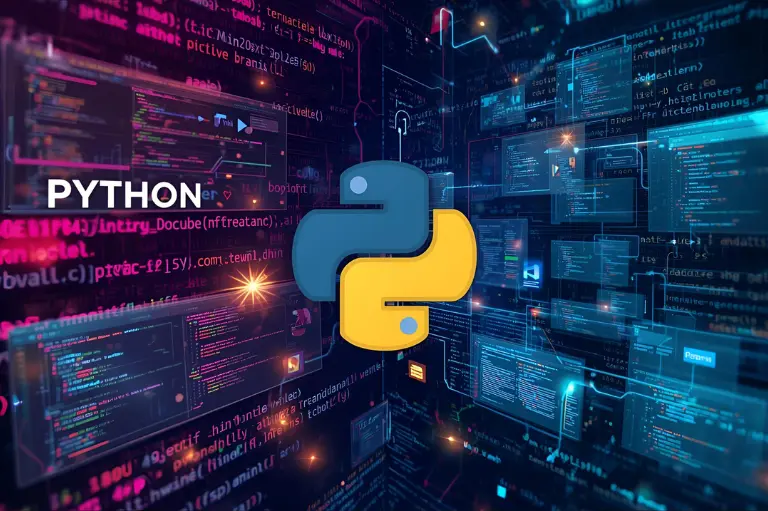What Is Python Programming Language
Python is a high-level, open-source, and general-purpose programming language created by Guido van Rossum in 1991. Known for its clean syntax and readability, it emphasizes simplicity, making it easier for beginners to learn and professionals to master.
Python supports multiple paradigms such as object-oriented, functional, and procedural programming. Because of its flexibility, it is used in domains ranging from web development to data analysis, AI, and automation.

Python vs Other Languages – Quick Overview
| Property | Python | Other Languages (C, C++, Java) |
| Ease of Learning | Very beginner-friendly | Steeper learning curve |
| Syntax | Simple and readable | Verbose and complex |
| Memory Management | Automatic (Garbage Collector) | Manual or semi-automatic |
| Compilation | Interpreted | Mostly compiled |
| Speed | Slower (interpreted) | Faster (compiled) |
| Libraries and Frameworks | Extensive | Moderate |
| Use Cases | Web, ML, AI, Automation, IoT | System programming, enterprise apps |
Python allows developers to focus on logic instead of syntax, while languages like C++ or Java require more boilerplate code.
Features of the Python Language
- Readable Syntax: Uses indentation instead of braces, making code easy to follow.
- Dynamic Typing: No need to declare variable types.
- Extensive Libraries: Pre-built modules for everything from math to machine learning.
- Cross Platform Compatibility: Runs seamlessly on Windows, macOS, and Linux.
- Interpreted Execution: Enables rapid development and debugging.
- Strong Community Support: Millions of developers contribute to forums and packages.
Example – Simple Python Code
def greet(name):
print(f"Hello, {name}! Welcome to Python.")
greet("Robert")

Python Libraries and Frameworks
One of Python’s strongest points is its vast ecosystem. Its standard library offers modules for file handling, web services, data manipulation, and much more.
- Django and Flask for web development
- NumPy and Pandas for data analysis
- TensorFlow, PyTorch, and Scikit-learn for machine learning
- Tkinter for GUI applications
Cross-Platform Compatibility in Python
A major advantage of Python is its ability to run on multiple operating systems without modification. You can write a script on Linux and execute it on Windows or macOS with no changes. This cross-platform compatibility reduces development overhead and increases productivity for developers building portable applications.
Python for Data Science and Machine Learning
Python is the leading language for data science and machine learning. Its simple syntax and powerful libraries make it ideal for handling large datasets and building predictive models.
- NumPy for numerical operations
- Pandas for data manipulation
- Matplotlib and Seaborn for visualization
- TensorFlow and PyTorch for artificial intelligence and deep learning
Whether it is forecasting trends, analyzing datasets, or automating insights, Python plays a key role in driving innovation in data science.
Python in Web Development
Python’s frameworks, like Django and Flask, make it a perfect language for building powerful and secure web applications. Django simplifies large projects, while Flask offers flexibility for smaller or experimental builds.
From startups to major platforms like Instagram and Spotify, many successful applications rely on Python for web development because of its scalability and efficiency.
Python vs Java vs C++
| Aspect | Python | Java | C++ |
| Syntax | Simple and concise | Verbose | Complex |
| Execution | Interpreted | Compiled (JVM) | Compiled (Binary) |
| Speed | Moderate | Fast | Fastest |
| Use Case | AI, Data, Web | Enterprise, Mobile | Games, System Software |
| Memory Management | Automatic | Automatic | Manual |
| Learning Curve | Easy | Moderate | Difficult |
Advantages of Python
- Easy to learn and read
- Large and active community support
- Rich set of libraries and frameworks
- Ideal for rapid application development
- Can integrate easily with C, C++, and Java
- Excellent for cross-platform projects
When Should You Use Python
Use Python when:
- You need fast development and easy-to-read syntax.
- You are working in data science, AI, or web development.
- You want your code to run seamlessly across platforms.
- You require strong community support and open-source tools.
Avoid Python when:
- You are developing real-time or high-performance systems.
- You need low-level hardware access (better with C/C++).
Common Limitations of Python
- Slower execution compared to compiled languages
- Not suitable for mobile app development
- Higher memory consumption for large applications
- Runtime errors due to dynamic typing
Summary – Why Choose Python
| Feature | Benefit |
| Ease of Use | Simple, readable, beginner-friendly |
| Community | Active global developer support |
| Libraries | Extensive for data, AI, and web |
| Speed | Slightly slower but efficient |
| Cross Platform | Runs anywhere with no changes |
| Integration | Works easily with other languages |

Conclusion
Python’s balance of simplicity, power, and flexibility makes it one of the most popular programming languages in the world. Whether your focus is data science, machine learning, web development, or automation, Python provides the right tools and community support to help you succeed.
When comparing Python vs other programming languages, it becomes clear that Python is not just about writing code; it is about writing code that is efficient, elegant, and future-ready. So, if you are an aspiring developer or a professional looking for a reliable language to master, Python is an excellent place to start.




